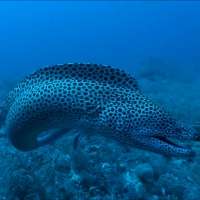Moray eels in knots over food

Research carried out by scientists from The University of Western Australia, the University of California and the Australian Institute of Marine Science (AIMS) has revealed unusual feeding behaviour in moray eels, one of the most elusive and important predators on coral reefs.
The research suggests that the morays' feeding tactics, which were already known to include cooperating with other fish to flush prey from reefs and crawling onto land to scavenge for dead fish, are more extensive than previously thought.
The moray eels' behavior was captured on baited remote underwater video systems (BRUVs) at Scott Reef, a remote reef located off the coast of Broome.
One moray tied its body into a 'knot' to extract food from a bait bag, while another moray used its tail as a 'paddle' to dislodge the food item.
Lead author of the study Shanta Barley, a PhD student from UWA's Ocean Institute and School of Animal Biology, said morays have traditionally been observed using knots to compress or break large prey into more manageable sizes, and to anchor food while they consume it. However, the use of a fast-moving knot to dislodge food has never before been observed, nor have they been seen to use their tails as paddles to exert force on a prey item.
"Our observations suggest that having an eel-like body shape opens the door to unusual and useful feeding techniques unavailable to conventionally shaped fish," Ms Barley said.
"Like moray eels, a group of subterranean, limbless amphibians known as 'caecilians' are also known to rotate rapidly to twist pieces of flesh off oversized prey. The deep sea hagfish also use knots to pry prey out of burrows on the sea floor."
Ms Barley said the ability of morays to attack and consume prey much larger than themselves might explain the significant role of moray eels as a meso-predator in reef systems and the evolution of cooperative hunting partnerships they form with other large fish-eating species.
"There are questions that remain such as to what extent can moray eels can develop new behaviour when faced with unfamiliar situations, and whether the behaviour is passed on between eels in the same population, like 'songs' in humpback whales," Ms. Barley said.
"Moray eels are facing growing fishing pressure in certain parts of Indonesia. This is worrying as these predators, like sharks, may play a key role in regulating the abundance and behaviour of fish in coral reefs."
Professor Jessica Meeuwig, a co-author of the paper, said the study enhanced understanding of the moray species.
"At a time when humans are disturbing reef ecosystems at unprecedented levels, understanding species' behaviour and flexibility can provide insights into their resilience," she said.
More information: Shanta C. Barley et al. "To knot or not? Novel feeding behaviours in moray eels," Marine Biodiversity (2015). DOI: 10.1007/s12526-015-0404-y
Provided by University of Western Australia





















